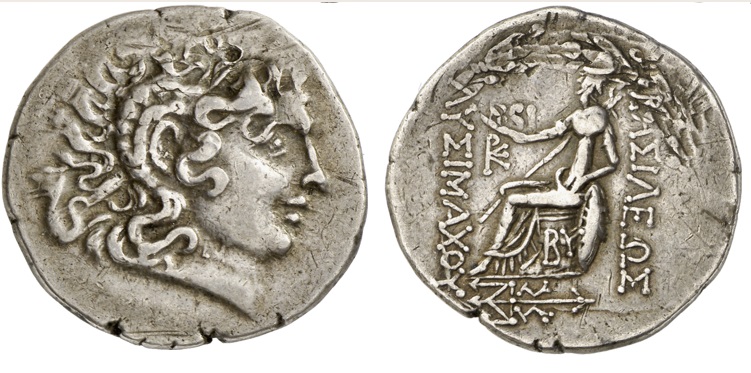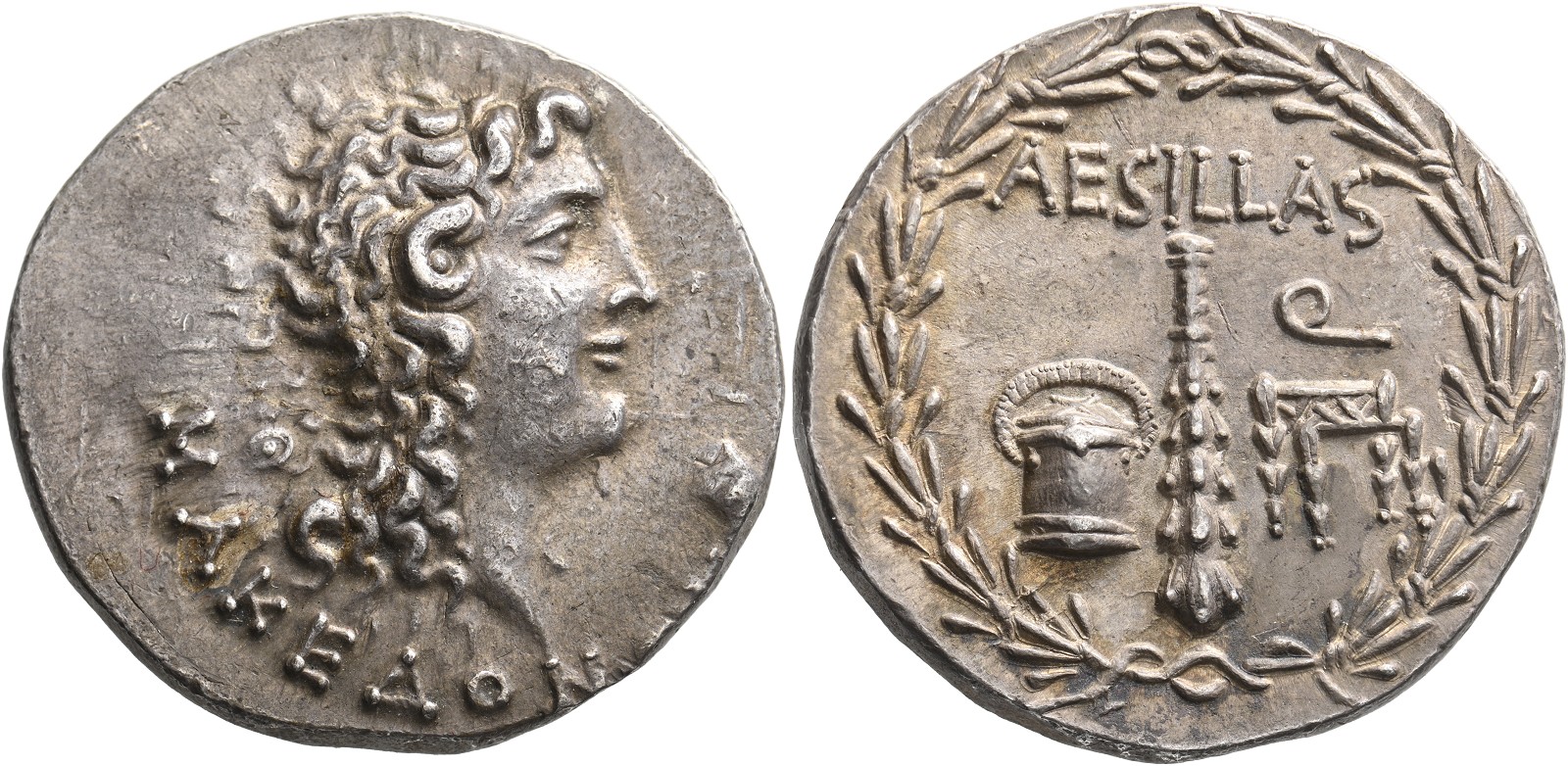90 BCE - 75 BCE | ΒΑΣΙΛΕΩΣ ΛΥΣΙΜΑΚΟΥ
Overstriking coin
Byzantium 461 over Aesillas.jpg
[1]
Overstruck variety
Aesillas.jpg
| Museum collectionMuseum collection:
|
Berlin, Münzkabinett, Staatliche Museen, 18267441 (Aufnahme durch Lutz-Jürgen Lübke - Lübke und Wiedemann).
|
|
|
|
|
Description
| ObverseInscription or printing placed on the obverse.:
|
Head of deified Alexander the Great right, wearing diadem.
|
ReverseInscription or printing placed on the reverse.:
|
ΒΑΣΙΛΕΩΣ ΛΥΣΙΜΑΚΟΥ (Greek) Athena enthroned left, holding Nike in right hand, left elbow resting on shield, spear behind. In field, monogram.
|
Mint and issuing power
Chronology
| FromIdentifies the initial date in a range assigned in a numismatic context. 90 BCE toIdentifies the final date in a range assigned in a numismatic context.. 75 BCE
|
Hellenistic 323-30 BC  periodTime period of the numismatic object. periodTime period of the numismatic object.
|
Physical description
MetalThe physical material (usually metal) from which an object is made.: Silver 
|
WeightWeight of the numismatic object (in grams). in grams: 16.3116.31 g <br />16,310 mg <br />
|
DenominationTerm indicating the value of a numismatic object. Examples: tetradrachm, chalkous, denarius.: tetradrachm 
|
AxisDescribes the directional relationship between the obverse and reverse of a numismatic object.: 1212 mm <br />1.2 cm <br />
|
| DiameterDescribes diameter of an object (in mm).: 3131 mm <br />3.1 cm <br />
|
StandardStandard.: Attic
|
References
| Coin referenceReference of the Coin:
|
Thompson 1973, pl. A.1, Callataÿ 2021a, p. 279, n° 1
|
Coin series referenceReference to coin series study:
|
Thompson 19731Thompson 1973, pl. A.1, Callataÿ 1997a2Callataÿ 1997a, 122 D7/R4 Taf. 36 C (dieses Stück), Bauslaugh 20003Bauslaugh 2000, 92-94 Taf. 14 (dieses Stück, Untertyp des Aesillas datiert vor ca. 89-84 v. Chr), Callataÿ 2021a4Callataÿ 2021a, p. 279, n° 1
|
| Coin series web referenceCoin series web references:
|
|
Description
| ObverseInscription or printing placed on the obverse.:
|
MAKEΔONΩΝ (Greek) Head of Alexander the Great right.
|
ReverseInscription or printing placed on the reverse.:
|
AESILLAS (Latin) Fiscus, club and subsellium. All within oak wreath.
|
Mint and issuing power
Chronology
| FromIdentifies the initial date in a range assigned in a numismatic context. 95 BCE toIdentifies the final date in a range assigned in a numismatic context.. 70 BCE
|
Hellenistic 323-30 BC  periodTime period of the numismatic object. periodTime period of the numismatic object.
|
Physical description
| DenominationTerm indicating the value of a numismatic object. Examples: tetradrachm, chalkous, denarius. ᵖ:
|
tetradrachm 
|
StandardStandard. ᵖ:
|
Attic
|
References
References
- ^ Thompson, Margaret (1973), "Byzantium over Aesillas", Revue Numismatique 6 (15), p. 54-65.
- ^ Callataÿ, François de (1997), L'histoire des guerres mithridatiques vue par les monnaies, Numismatica Lovaniensia 18, Louvain-la-Neuve, XIII + 481 p. et 54 pl.
- ^ Bauslaugh, Robert A. (2000), Silver coinage with the types of Aesillas the Quaestor, Numismatic Studies 22, New York.
- ^ Callataÿ, François de (2021), “On pattern and purpose of overstrikes of late Hellenistic tetradrachms in Thrace Macedonia”, in Ulrike Peter and Bernhard Weisser (eds.), Thrace. Local coinage and regional identity, Berlin Studies of the Ancient World 77, Berlin, Topoi, p. 263-289.


